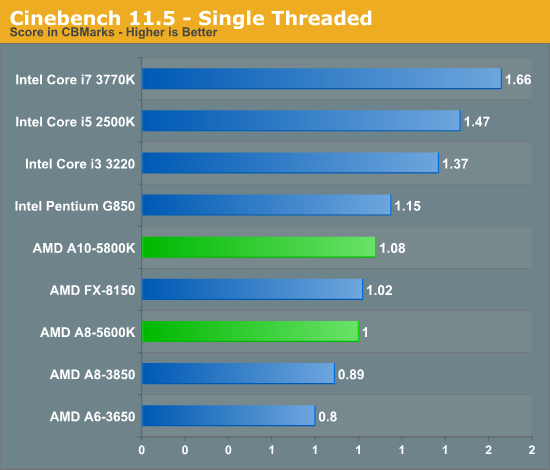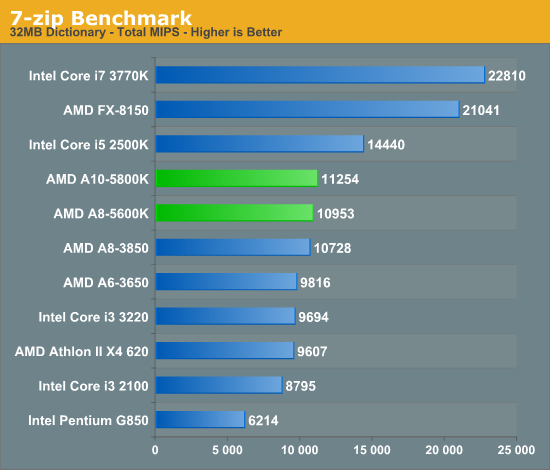AMD A10-5800K & A8-5600K Review: Trinity on the Desktop, Part 2
by Anand Lal Shimpi on October 2, 2012 1:45 AM ESTTrinity CPU Performance: The Good and the Bad
We're going to start our performance investigation a little out of order. The big question on everyone's mind is how much single threaded performance has improved over Bulldozer, and whether it's enough to actually make Trinity faster than Llano across the board. We'll use Cinebench 11.5 as it has both single and multithreaded test options:

The good news is that single threaded performance is definitely up compared to Llano. Piledriver likely has some to do with this, but so does the fact that the A10 can run at up to 4.2GHz (~4GHz typically) with one of its cores active compared to the 2.9GHz clock speed of the A8-3850. Compared to the Bulldozer based FX-8150 there's a slight (~6%) increase in single threaded performance. Although I don't expect anyone will be cross shopping a Trinity APU and a FX CPU, it's important to keep an eye on progress here as we'll eventually get a high-end quad-module/eight-core Piledriver CPU.
Note that compared to even previous generation, low-end Intel CPUs without turbo there's a huge gap in single threaded performance. If we look at the gap AMD has to make up vs. Ivy Bridge it's not pretty. Intel's Core i3 3220 manages a 27% performance advantage over the A10-5800K. Even if Steamroller is able to deliver a 15% increase in performance at the same clock speed, there will still be a gap. And we're not even talking about how Haswell will grow this gap. For the foreseeable future I don't see AMD closing the single threaded performance gap. Jim Keller's job is to fix this problem, but it'll probably take 2 - 3 years to get there.

The multithreaded test shows the other end of reality: in heavily threaded foating point workloads it's possible that we'll see a regression compared to Llano. Remember the Bulldozer/Piledriver architecture prioritizes integer over floating point performance. Truth be told this regression is pretty rare in our tests, but until we get to Steamroller we will still see these types of situations.
Throw more threads at the problem and even with a floating point workload Intel can't pull ahead however. The A10 offers similar performance to the Core i3 3220 at a lower price. Your decision here would come down to the rest of the factors: single threaded performance, processor graphics performance, overclocking capabilities and power consumption. Intel and AMD both win two of those each, it's really a matter of what matters most to you.
A heavily threaded FP workload doesn't really play to AMD's advantages though, what happens when you get a heavily threaded integer workload however? The 7-zip benchmark gives us just that:

Here AMD manages a 16% performance advantage over the Core i3 3220. I'd even go as far as to say that Trinity would likely beat any dual-core Intel machine here. The performance advantage is somewhat artificial as Intel purposefully removes turbo from its dual-core desktop CPUs. This should be AMD's best foot forward, but once again it'll likely take Steamroller for this design to start to make sense.
Speaking of artificial product segmentation, one major feature Intel takes away when you get down to the dual-core desktop i3 level is AES-NI support. Hardware accelerated AES support is something that you get only with the more expensive Core i5/i7s. With Trinity, you get AES-NI support for the entire stack. The result is much better performance in those applications that depend on it:

Like most of the advantages we've talked about thus far, there are really very specific use cases where Trinity makes sense over a similarly priced Intel CPU.










178 Comments
View All Comments
Hubb1e - Tuesday, October 2, 2012 - link
Atom falls down with Netflix and idles around the same point as these chips.mattlach - Thursday, October 4, 2012 - link
My current AMD E-350 can not handle Netflix HD, which is disappointing.The way Netflix has implemented DRM in Silverlight, hardware decode acceleration doesn't work on any system, so it all hits the CPU, and many lower end systems (Atom, E-350) just can't handle it above SD resolutions.
Everything else I've tried (Youtube, custom encoded video files, etc. etc., habe not tried Hulu though) works just fine, as the on-chip GPU offloads the CPU and they play fine, but Netflix HD chokes, and chokes badly.
Thus the need for a low end, power efficient Trinity setup.
I would love one of those mobile Trinity chips in a desktop FM2 package. A 35W TDP Trinity or lower would be perfect for my HTPC needs.
stimudent - Tuesday, October 2, 2012 - link
We need to appreciate and thank anandtech.com for being professional about a staged release. This is in stark contrast to taking part in cry baby journalism that TechReport.com engaged in.Pythias - Tuesday, October 2, 2012 - link
"Professional" is a polite euphemism for prostitute in some circles.Pythias - Tuesday, October 2, 2012 - link
Why did you remove the pentium from the descrete gaming chart?Hubb1e - Tuesday, October 2, 2012 - link
Because he wanted to keep the forums ripe for the trolls who think a Celeron plus a 6670 are faster than Trinity.Pythias - Wednesday, October 3, 2012 - link
Seems rather dodgy.HisDivineOrder - Tuesday, October 2, 2012 - link
Hopefully, one of these days, Intel will be bothered enough by these APU's that they release an i3 with boost and an unlocked multiplier with the higher end version of the integrated GPU.Price it right at the high end of AMD's APU lineup, bam, the whole thing is dead in the water. I suspect Intel wants AMD to seem like they're competition to keep the regulators away, so they're holding back on the obvious killshot.
mikato - Wednesday, October 3, 2012 - link
It would somewhat kill their higher priced CPUs also though.eanazag - Tuesday, October 2, 2012 - link
I wasn't expecting AMD to close the performance gap or power usage gap with Intel. I was concerned that it might not even be able to beat Llano CPU performance consistently. I feel comfortable with the CPU performance. I think at even lower pricing AMD could dominate the low end market. I have a Core i5 860 and Core i3 Arrandale (same time frame). I certainly noticed the 860 appearing in the benchmark numbers. The A10 Trinity is not too far off the performance of my 860, especially when considering price in factors. And off the FX-8150 it has pretty good performance, which is a decent sign for the higher end AMD desktop parts coming soon (can't really call the AMD high end parts).Idle power usage is excellent. Power usage can make sense for AMD if you are considering a cheap Intel proc and a discrete card. I think in that situation AMD makes more sense.
Drivers and support go to AMD on both sides of software compatibility (AMD drivers and game support).
SATA 6Gbps on Intel with just 2 builtin ports still upsets me. This should be an advantage for AMD at the platform level.
I want to see the desktop and server chip data next. I am glad that I don't have to rule out buying the AMD parts from the get go. The buying decision will still be that.
I still believe AMD should make a 200W part combining their FX proc with a 7700/7800 range GPU. I think they could dominate the midrange with that and who could compete then? From price and gaming performance at least. Power and heat still makes sense considering the removal of that level GPU from the case. Hell, I could deal with 250W and be happy also.